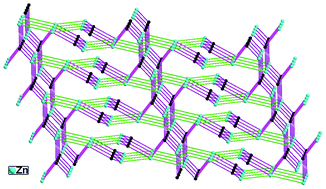a Key Laboratory of Organic Synthesis of Jiangsu Province, College of Chemistry, Chemical Engineering and Materials Science, Soochow University, Suzhou 215123, P. R. China
CrystEngComm 2013, 15, 471-481.
In our effect to tune the structures of Zn(II) coordination polymers, six zinc(II) coordination polymers {[Zn(bte)(1,3-bdc)]·0.5H2O}n (1), {[Zn(bte)(NO2-1,3-bdc)]·3H2O}n (2), {[Zn(bte)(I-1,3-bdc)(H2O)]·H2O}n (3), {[Zn(bte)2(H2O)2](SO3-1,3-Hbdc)·4H2O}n (4), {[Zn(bte)(Hbtc)]·3H2O}n (5) and {[Zn3(bte)2(btc)2(H2O)2]·2.5H2O}n (6) (bte = 1,2-bis(1,2,4-triazol-1-yl)ethane, 1,3-bdc = 1,3-benzenedicarboxylate, NO2-bdc = 5-nitroisophthalate, I-1,3-bdc = 5-iodoisophthalate, SO3-1,3-bdc = 5-sulfoisophthalate, btc = 1,3,5-benzenetricarboxylate) have been synthesized and structurally characterized. 1, 2 and 3 are independent 1D MONTs. An interesting structural feature of 3 is that the I groups of each 1D MONT polythread into two adjacent 1D MONTs to form a (1D → 2D) polythreaded array and a 3D supramolecular architecture. 4 shows the double chain cation [Zn(bte)2(H2O)2]n2n+ and 3D hydrogen bond architecture. 5 exhibits a 2D (4,4) network and a 3D hydrogen bond architecture. In 6, each btc ligand bridges three Zn(II) atoms (one Zn1 and two Zn2) and forms a 3-connected 2D network [Zn3(btc)2(H2O)2]n. Each bte ligand connects two [Zn3(btc)2(H2O)2]n 2D networks to construct a (3,4)-connected 3D network with point symbol (62·144)(143)4. Such a (3,4)-connected 3D network is unprecedented, as to the best of our knowledge. The luminescence and thermal stability of 1–6 were investigated.

链接: //pubs.rsc.org/en/content/articlelanding/2012/ce/c2ce26515j#!divAbstract